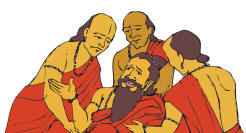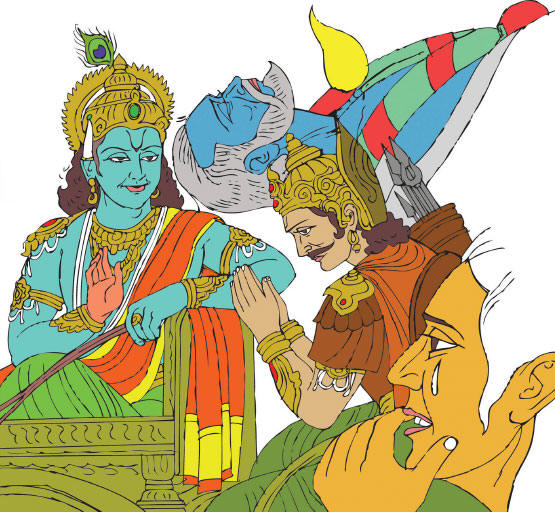TreeInTheSeed16
Gita's Teachings
Sēvāratṉā
Doctor T.S. Narayanaswamy
Images: Aras.
Bhagavadgita supports the words, ‘Tree in the Seed,’ and is described as
the ‘Songs of God.’ Nothing we know of that falls in the category of
‘Songs of God.’
All know the Tattva that ‘life is for living.’ Living without knowing
its purpose means living is for death only. Bhagavad Gita stands in the
forefront in its guidance to the path of good living in all its
auspicious ways. 'வாழ்க்கை
வாழ்வதற்கே’
=
‘Life is for living.’
Hesitance of Arjuna
At the beginning of Kurukṣetra war, the Kaurava-Pāṇḍava armies stood in
formation. Arjuna’s chariot driven by Bhagavan Krishna came to the
forefront of Pāṇḍava army.
Arjuna is the most powerful among the Pāṇḍavas. The bow, he carried, was
equal to Gōthaṇḍam of SriRama. He was the possessor of arrows such as
Braḥmāsthiram, Varuṇāsthiram… acquired because of Tapas. He was ready to
sacrifice his life as the defender of Dharma. More important, Bhagavan
Krishna was his charioteer.
Before war began, Arjuna lamented like a coward. The eyes were brimming
with tears. His hands and feet were trembling. His bow and arrows
slipped from his hands and fell on the battleground. He lamented falling
like the rootless tree at the feet of Bhagavan Krishna.
Arjuna
“Krishna, from me, it is a no to the war.
I do not desire a victory in war by killing the near and dear.
Killing of the elders against the Kuladharmam is sin. The name and fame
earned from victory, I reject. I am afraid to engage in this mean act.”
He supplicated to Bhagavan Krishna.
In this discourse, Arjuna himself presented Dharmic principles to Kaṇṇaṉ.
He was teaching Dharma to Krishna, when it must have been the
other way. For that reason, the first chapter goes by the name ‘Vīṣāda
Yogam.’ (Litany of grief)
As the fear and sorrow ascended, he never picked up the bow and arrows
and sat there diffident and lacking courage. There is a reason for the
hesitancy of the incompetent. How could an all-around competent person
with fallen crest be brought back to his self?
Hearing what Arjuna said, Krishna answered with a touch of anger,
“Arjuna! Your fear and cowardice are not in line with Kṣatriya
Dharma. The battle has begun. There are none in this theater of war with
your mental confusion. You must have come to a deliberate conclusion.
You are already in the battlefield and now try to change your mind and
determination discovering new reasons. This is not the ethos of a
warrior.
Tiruvalluvar says:
குறள்
467:
எண்ணித் துணிக கருமம் துணிந்தபின்
எண்ணுவம் என்பது இழுக்கு.
Think, and dare to act. Once deed is in motion
Reconsideration is disgrace.
Translation V. Krishnaraj
Sāṁkhya
Yogam
The second chapter in Bhagavadgita expounds Sāṁkhya
Yogam as done by Bhagavan. Krishna surmises the reasons for his
hesitancy.
Desire, affection and gratitude.
Bhīṣma with the relatives and Gurunāthar Droṇa stand in the enemy camp
as foes. Gratitude towards them was at its highest. How could he kill
them? He may likely be
killed by them. If his brothers were killed, it is hard for him to bear
the loss and suffer sorrow.
Krishna having surmised the agonies of Arjuna began his advice.
Is fear relevant?
Is fear necessary for life? Don’t we need fear in observing probity? The
elders taught us, “Fear sin. Then, a path for a pure life will come into
view. That being so, fear will appear necessary in the conduct of
events. What are the consequences of fear on the body, mind and soul?
Knowing it will help advance one’s forward march.
A multitude of people fear not for what should be feared. They fear for
unnecessary things. Most people fear for adverse economy. Since people
lack mutual trust, fear replaces trust.
An untoward experience creates that fear.
Fear haunts us thinking about an
eatery, once we experience stomach ailment from eating there previously.
Most of us do not entertain such fears. Some fear darkness. Some others
can perform well in the darkness. Fear is a negative thought. If we
think that way, fear will disappear. People fear illness and death. Will
death disappear, if we fear death? Since death is a certainty in the
future, that fear should be put to rest. In the battlefield, what
afflicted Arjuna was fear of death. The Arjuna’s fear was causing death
or suffering death in the battlefield.
To dispel this fear, Bhagavan gave instructions on
Ātma
Bōtham.
“Body is perishable;
Ātmā
is imperishable.” It is birthless and deathless.
Ātmā
is deathless, birthless, neither killed nor diminished. The body changes
clothes.
Ātmā
is changeless. (As
a person changes clothes, the soul changes bodies: embodied soul)
Ātmā
can’t be cut, is not burnt by fire, not wet by rain and scorch-free.
It is motionless, immobile, eternal and imperceptible by the
senses. Thought cannot control it. The in-dwelling
Ātmā
is God. ‘Aham Brahmāsmi’
is a tattva. Krishna said to him, “Do not be disheartened by the thought
you will annihilate them all in the war.
You are a mere instrument.” The scientists said this, ‘Nothing
can be created; nor destroyed. But, one thing can be converted into
other.’ For example, water becomes steam on boiling. Liquid water
disappears. When the steam cools, it becomes water. If the water is
further subjected to cooling, it becomes a block of ice.
Ātmā
is such an entity.
Bhagavan Krishnar stressed to Arjuna, “Don’t be confused thinking of
causing annihilation or creation of anything.”
The tree grows.
Thrashing and embracing are one.
 A
saṁnyāsin walking along a country path, stepped on the foot of the
village headman by mistake. Realizing his mistake, he asked for
forgiveness from the village headman.
A
saṁnyāsin walking along a country path, stepped on the foot of the
village headman by mistake. Realizing his mistake, he asked for
forgiveness from the village headman.
He was a rank ruffian. Mustering anger, he scolded the Saṁnyāsin with
scalding words. He hit him with a stick.
The fragile Saṁnyāsin fell in a swoon. The village headman with
disregard left the premises.
Luckily, the disciples arrived in time and rendered first aid to him.
One disciple challenged the Saṁnyāsin, “Do you know who the first
responder is?”
He responded, “O yes, I know it! The very same striking hands are now
rendering service to me.”
Yes! To a Jñāṉi,
the smiting hand and the embracing hand are the same. The reason being,
the Saṁnyāsin does not look at people.
